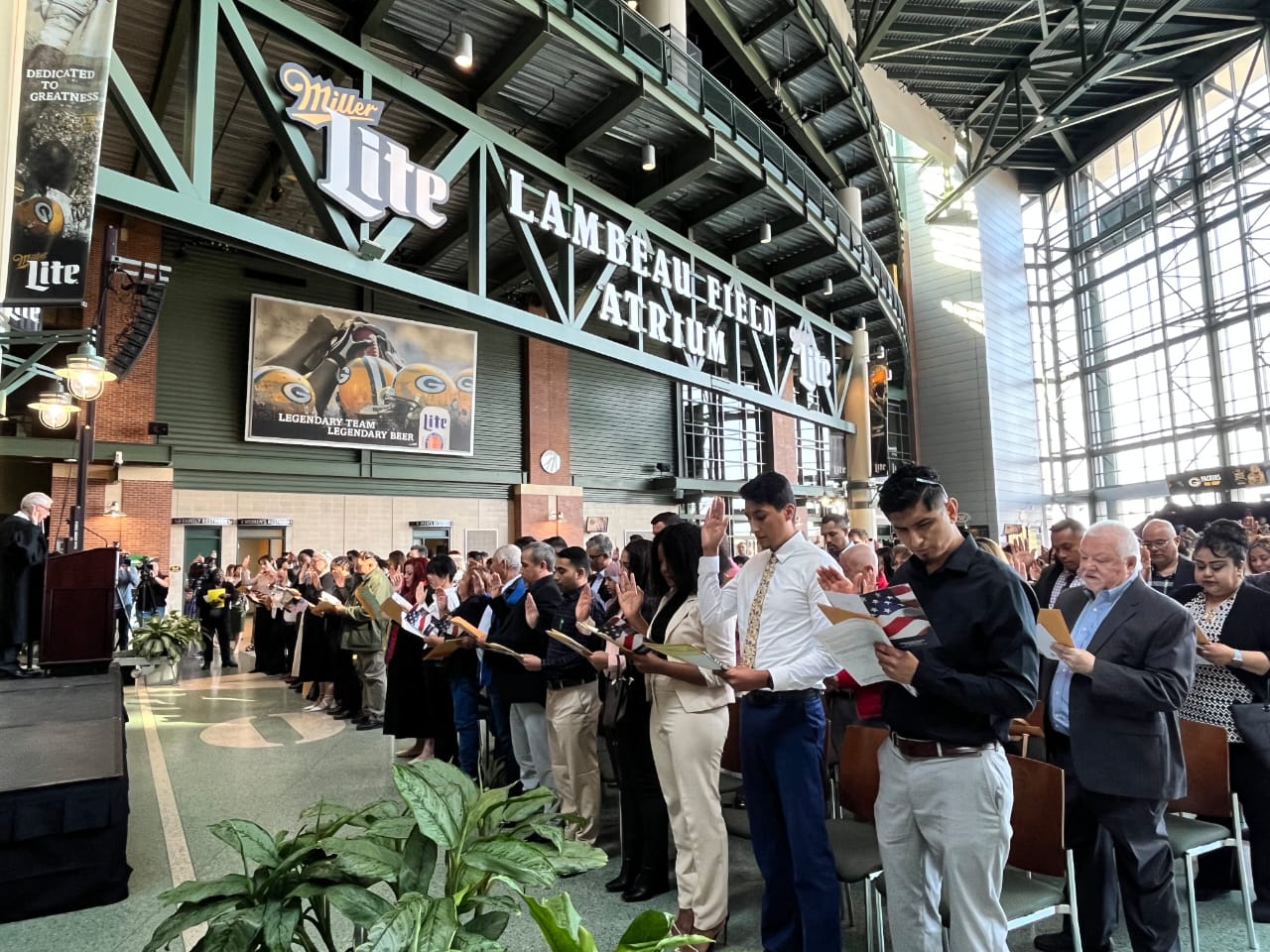In 2023, the United States welcomed 878,500 new citizens through naturalization, with individuals from Mexico, India, the Philippines, the Dominican Republic, and Cuba comprising 32% of this group. The median duration as a lawful permanent resident before naturalization was seven years, highlighting the commitment of immigrants to integrate into American society.
Key Takeaways
- Naturalization Numbers: In 2023, 878,500 individuals became U.S. citizens through naturalization.
- Top Countries of Origin: Mexico led with 12.7% of naturalizations, followed by India (6.7%), the Philippines (5.1%), the Dominican Republic (4.0%), and Cuba (3.8%).
- Residency Duration: The median time as a lawful permanent resident before naturalization was seven years.
- Geographic Distribution: 70% of new citizens resided in ten states, with California, Texas, Florida, and New York hosting over half.
Context
The United States has long been a destination for immigrants seeking better opportunities. Naturalization grants these individuals the rights and responsibilities of citizenship, including voting and holding public office. Over the past decade, more than 7.7 million people have become U.S. citizens through naturalization.
Understanding the Naturalization Process
Eligibility Requirements
To be eligible for naturalization, applicants must:
- Age: Be at least 18 years old.
- Residency: Have been a lawful permanent resident for at least five years, or three years if married to a U.S. citizen.
- Physical Presence: Have been physically present in the U.S. for at least half of the required residency period.
- Good Moral Character: Demonstrate good moral character, typically shown by a clean criminal record.
- English Proficiency: Have basic ability to read, write, and speak English.
- Civics Knowledge: Understand U.S. history and government principles.
Naturalization is the legal process through which a non-U.S. citizen voluntarily becomes an American citizen.
Application Steps
1. Form N-400: Complete and submit the Application for Naturalization.
2. Biometrics Appointment: Attend a biometrics appointment for fingerprinting.
3. Interview and Tests: Participate in an interview, which includes English and civics tests.
4. Oath of Allegiance: If approved, take the Oath of Allegiance to officially become a U.S. citizen.
Demographic Trends in Naturalization
Recent data reveals significant trends in the origins and residency patterns of new U.S. citizens.
Countries of Origin
In 2023, the top five countries of origin for naturalized citizens were:
- Mexico: 12.7%
- India: 6.7%
- Philippines: 5.1%
- Dominican Republic: 4.0%
- Cuba: 3.8%
These five countries accounted for 32% of all naturalizations in 2023.
Residency Patterns
The median duration as a lawful permanent resident before naturalization was seven years. Applicants from Mexico and Canada had the longest median residency at 10.4 years, while those from Nigeria had the shortest at 5.6 years. Indian applicants had a median residency of 5.6 years.
Geographic Distribution
New citizens predominantly resided in:
- California
- Texas
- Florida
- New York
These four states alone were home to more than half of all new citizens in 2023.
Dos and Don’ts for Naturalization Applicants
Knowing what to do—and what to avoid—can greatly improve your chances of a successful naturalization process.
Dos
1.Maintain Your LPR Status:
o Continuously meet residency requirements. Avoid long trips abroad that may disrupt your continuous residence.
2. Be Honest on Your Application:
o Accurately complete Form N-400, disclosing all required information, including any criminal or immigration history.
3. Prepare Thoroughly for the Interview:
o Study the civics questions provided by USCIS and practice speaking in English for the interview.
4. Keep Records Updated:
o Ensure USCIS has your correct address to receive notices on time.
5. Gather Supporting Documents:
o Bring all required documents to your interview, including your green card, tax records, and travel history.
6. Attend All Appointments:
o Show up for your biometrics appointment and interview on time. Reschedule only in emergencies.
Don’ts
1.Don’t Falsify Information:
o Never lie or omit information on your application or during the interview. Misrepresentation can lead to denial or revocation of citizenship.
2. Don’t Violate Immigration Laws:
o Avoid activities that could harm your status as an LPR, such as unlawful voting or failing to file taxes.
3. Don’t Ignore Deadlines:
o Submit requested documents and attend appointments promptly. Missing deadlines could delay your application.
4. Don’t Travel Excessively Without Planning:
o Long trips outside the U.S. can disrupt your continuous residence requirement, so limit your time abroad to less than six months.
5. Don’t Forget Legal Help if Needed:
o If you’re unsure about any aspect of the process, consult an immigration attorney for guidance.
Importance of Following Guidelines
By adhering to these dos and don’ts, you reduce the risk of application denial and streamline your path to U.S. citizenship. Taking proactive steps and avoiding common mistakes ensures a smoother and more confident naturalization journey.
The Role of Legal Assistance in the Naturalization Process
Managing the naturalization process can be complex; legal assistance ensures compliance and addresses individual circumstances.
Why Seek Legal Aid?
Immigration attorneys provide:
- Guidance: Clarifying eligibility and application requirements.
- Document Preparation: Assisting in accurately completing forms and gathering necessary documents.
- Interview Preparation: Helping applicants prepare for the naturalization interview and tests.
- Issue Resolution: Addressing any legal challenges or complications that may arise.
Conclusion
Becoming a U.S. citizen through naturalization is a significant milestone that offers numerous benefits and responsibilities. Understanding the process, eligibility requirements, and demographic trends can help prospective applicants achieve their path to citizenship. Legal assistance plays a crucial role in ensuring a smooth and successful naturalization journey.
Frequently Asked Questions
What is naturalization?
Naturalization is the process by which a non-U.S. citizen voluntarily becomes an American citizen after meeting specific requirements.
How long must I be a lawful permanent resident before applying for naturalization?
Generally, five years; however, if married to a U.S. citizen, the requirement is three years.
What are the English language requirements for naturalization?
Applicants must demonstrate basic ability to read, write, and speak English, with certain exemptions based on age and residency duration.
What does the civics test entail?
The civics test assesses knowledge of U.S. history and government principles.
Can legal assistance improve my chances of successful naturalization?
Yes, legal assistance can help ensure all requirements are met and address any potential issues during the process.
Where can I find more information about the naturalization process?
The U.S. Citizenship and Immigration Services (USCIS) website provides comprehensive information on naturalization.
Authors: Jonathan Wasden & Justin Rivera, Immigration Attorneys
How useful was this post?
Click on a star to rate it!









